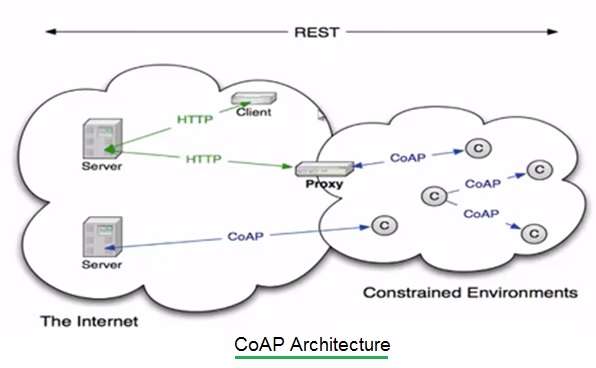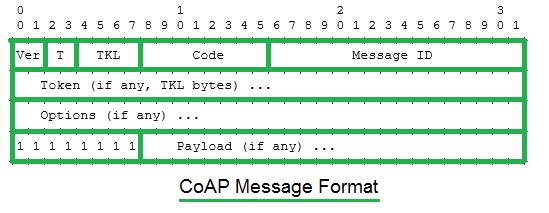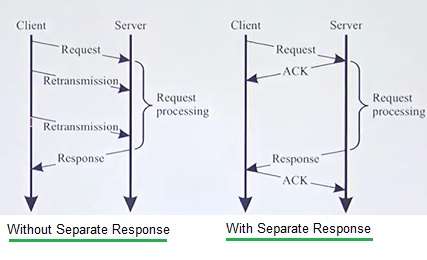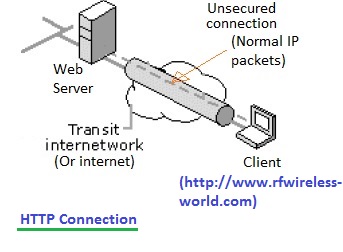目录
CoAP协议
CoAP是约束应用协议的缩写形式。
CoAP协议在RFC 7252中规定。它是一种Web传输协议,用于受约束的节点或网络,如WSN,IoT,M2M等。因此,名称为Constrained Application Protocol。该协议针对具有较少内存和较少功率规范的物联网(IoT)设备。
由于它是为Web应用程序设计的,因此它也被称为“Web of Things Protocol”。它可用于通过Web应用程序将数据从几个字节传输到1000个字节。它存在于UDP层和应用层之间。
以下是CoAP协议的功能:
•它是非常有效的RESTful协议。
•易于代理到HTTP /从HTTP代理。
•它是开放的IETF标准
•它是嵌入式Web传输协议(coap://)
•它使用异步事务模型。
•UDP与可靠性和多播支持绑定。
•使用GET,POST,PUT和DELETE方法。
•支持URI。
•它使用小而简单的4字节标头。
•支持绑定到UDP,SMS和TCP。
•使用基于DTLS的PSK,RPK和证书安全性。
•使用MIME类型和HTTP响应代码的子集。
•使用内置的发现机制。
CoAP架构

图1描绘了CoAP架构。如图所示,它将普通HTTP客户端扩展到具有资源约束的客户端 这些客户端称为CoAP客户端。代理设备基于HTTP协议弥合了传统环境与典型互联网环境之间的差距。同一服务器负责HTTP和CoAP协议消息。
CoAP消息头格式

图2描绘了CoAP消息格式包括4个字节的头部,后跟令牌值(从0到8个字节)。下表提到了由4个字节组成的标题,即32位。
| CoAP邮件头 | 描述 |
|---|---|
| 版本 | 它是2位无符号整数。它提到了CoAP版本号。设置为一个。 |
| Ť | 它是2位无符号整数。表示消息类型即。确认(0),不可确认(1),ACK(2)或重置(3)。 |
| 漳州灿坤 | 它是4位无符号整数,表示令牌的长度(0到8个字节)。 |
| 码 | 它是8位无符号整数,它分为两部分即。3位类(MSB)和5位细节(LSB)。 |
| 消息ID | 16位无符号整数。用于匹配响应。用于检测邮件重复。 |
CoAP消息交换

有两种模式可以在CoAP客户端和CoAP服务器之间交换CoAP协议消息。没有单独的回应和单独的回应。
通过单独响应,服务器通知客户端收到请求消息。这将增加处理时间,但有助于避免不必要的重传。
由于使用UDP,CoAP是不可靠的协议。因此,CoAP消息在到达目的地时会无序或丢失。
为了使CoAP成为可靠的协议,停止并等待指数退避重传功能。还引入了重复检测。
CoAP约束应用协议协议是HTTP的升级版本。
它专为资源构成应用而设计,如IoT / WSN / M2M等。它基于UDP。它使用ACK消息,使其像TCP一样可靠。与HTTP相比,它具有低延迟并且消耗更少的功率。
HTTP与CoAP协议对比

图1描述了客户端和服务器之间使用的HTTP协议作为不安全连接。HTTP的HTTPS版本用于提供安全连接。HTTP主要用于查看网页或网站。该协议是为基于互联网的应用程序和设备而设计的,其中不存在电源和任何其他组件。它是基于TCP的协议。
以下是CoAP和HTTP协议之间的表格差异。
| 特征 | CoAP协议 | HTTP |
|---|---|---|
| 协议 | 它使用UDP。 | 它使用TCP。 |
| 网络层 | 它使用IPv6和6LoWPAN。 | 它使用IP层。 |
| 多播支持 | 它支持。 | 它不支持。 |
| 架构模型 | CoAP使用客户端 - 服务器和发布 - 订阅模型。 | HTTP使用客户端和服务器架构。 |
| 同步通信 | CoAP不需要这个。 | HTTP需要这个。 |
| 开销 | 开销更少,而且很简单。 | 与CoAP相比,开销更大,而且很复杂。 |
| 应用 | 专为资源受限的网络设备而设计,例如WSN / IoT / M2M。 | 专为没有任何资源问题的互联网设备而设计。 |
posted on 2018-08-29 17:07 sundaygeek 阅读(...) 评论(...) 编辑 收藏






















 9500
9500











 被折叠的 条评论
为什么被折叠?
被折叠的 条评论
为什么被折叠?










